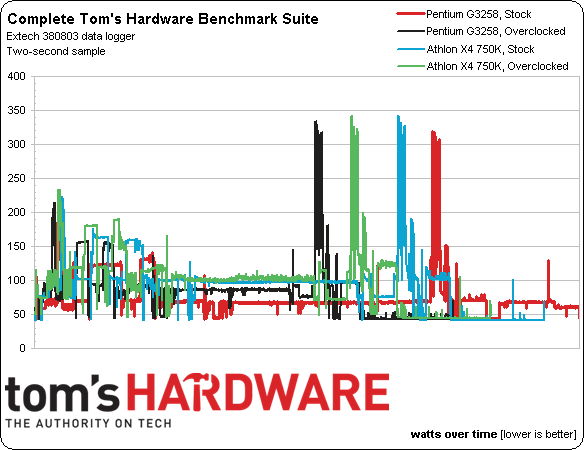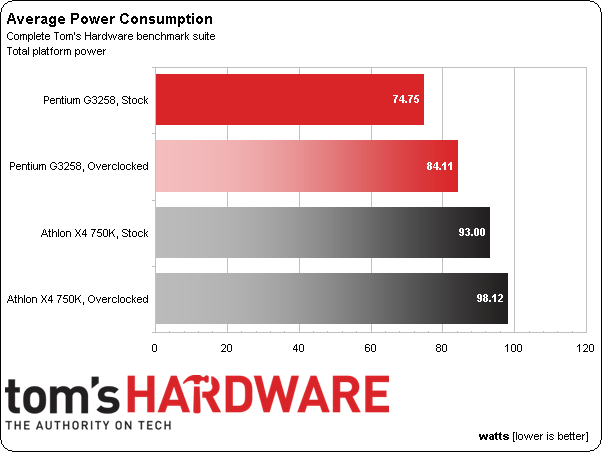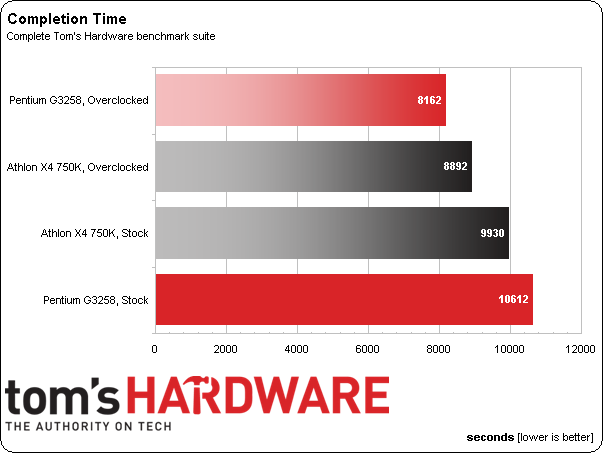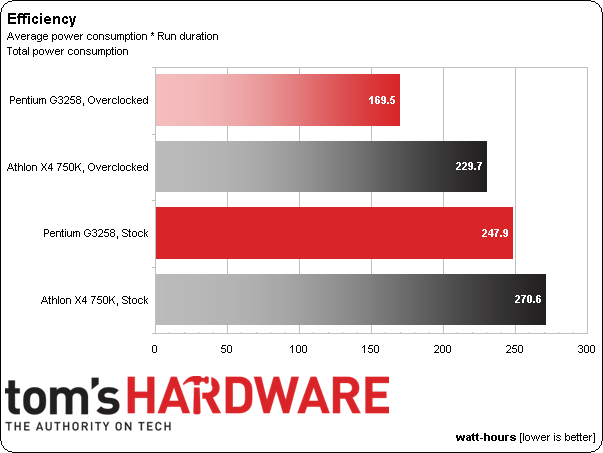Intel Pentium G3258 CPU Review: Haswell, Unlocked, For $75
It's a momentous occasion. Intel now offers an affordable dual-core Pentium with an unlocked multiplier based on its Haswell architecture. How well does it overclock? Can it beat AMD's potent little Athlon X4 750K? We run both through our benchmark suite.
Power Consumption And Efficiency
The following chart reflects power consumption throughout our benchmark suite, which gets logged every two seconds. The long, straight section at the end represents 30 minutes of idle time inserted by our automated script to better reflect actual use when we calculate averages.
Our comparison is principally between Intel’s Pentium G3258 and AMD’s Athlon X4 750K. We’ve seen how both CPUs size up in the performance metrics, and now we get a better idea of how much power they pull down along the way.
All four configurations spike into similar territory. Three settle around the same idle power, while one (the stock Pentium G3258) idles quite a bit higher. Interestingly, this is the same behavior observed from Intel’s Core i7-4790K on MSI’s Z97 Gaming 7. Since the Core i7-4770K was fine, I’m inclined to believe there’s some firmware work to do for Intel’s newest multiplier-unlocked models.
That long stretch in the middle, which is our Visual Studio test, best represents a CPU-heavy task with no graphics intervention. It shows the stock Pentium using the least power, followed by the overclocked Pentium, the stock Athlon, and the overclocked Athlon, just as each CPU’s TDP would indicate.
Based on the length of the lines, we also see that the stock Pentium G3258 is the slowest entry, followed by the stock Athlon X4 750K. You can’t really see it behind the other lines, but the overclocked Pentium wraps up first.
When you average out power consumption across the entire line graph, you get the above chart. The stock Pentium G3258 should probably be quite a bit lower. However, because there appears to be an issue with it idling at stock clock rates, 30 minutes is spent more than 20 W too high.
At any rate, the overclocked Pentium certainly uses more power in its quest, due to the higher voltage and clock rate. But we also know it finishes the tasks we throw at it faster. Meanwhile, overclocking AMD’s Athlon X4 750K doesn’t have a profound impact on average power use at all. That likely indicates good things for efficiency.
Get Tom's Hardware's best news and in-depth reviews, straight to your inbox.
A glance at the line graph gave us this same information, but we more clearly see the finishing order of our entire suite. Intel’s Pentium G3258 starts as the slowest contender and, through overclocking, ends up fastest.
Multiplying power consumption and run duration gives us a Wh rating for each system.
Intel’s Pentium G3258 starts off using little power. However, mediocre performance and a poor idle combine to delivery lackluster efficiency. Only the stock Athlon X4 750K is worse. Its performance is better than the Pentium’s, but a 100 W TDP hurts the equation.
Overclocking to 4.3 GHz helps the Athlon improve its performance even more without affecting power consumption much. But the Pentium can’t be stopped. Average power use jumps 10 W (12%), while the benchmark suite finishes 23% quicker. The result is a first-place finish in efficiency.
Current page: Power Consumption And Efficiency
Prev Page Results: Compression Apps Next Page Haswell, Unlocked, For $75-
Heironious Article title says its $75, the picture used says its $3 more than the i3. 75 and it's a deal otherwise no point in paying 3 bucks more for it rather than the i3.Reply -
envy14tpe It's always great seeing the full potential of technology but I'd rather see the Pentium on a mobo somebody would really buy and see how overclocking on a budget would be...more realistic.Reply -
silverblue AMD really needs a new model featuring Steamroller cores and a disabled GPU, say, a 770K. It wouldn't change the gaming scores all that much, but various benchmarks would definitely improve. As it is, the G3258 is a nice processor, but it won't go for that $75 to begin with.Reply -
Smallfilou What if "the fool" who bought that Pentium G and Z97 did so expecting to swap the processor in one year or two for a broadwell, once he got the cash? That would make him a very wise fool indeed... I'd say!Reply
Because of course buying a pentium G and fitting it with a 150USD board and 50USD cooler does not make sens by itself ,but you have a 100% future-compatible system that can be upgraded very very easily... -
knowom Could get a Q9550 for that price on Ebay nice try Intel, but that would kick the crap out of that weak Pentium it's reasonably on par with the i5. Way too damn expensive for what it is in reality.Reply -
BoredErica Hyperthreading is typically considered to be bad for Chess. It increases inefficiencies in search and although you get a larger kilonodes per second which looks nice as a benchmark score, you are actually lowering the strength of the engine. So when I look at Fritz benchmarks on PC sites I take them with a grain of salt.Reply -
lunyone I'd probably look at something like this for this kind of CPU:Reply
PCPartPicker part list / Price breakdown by merchant
CPU: Intel Pentium G3258 3.2GHz Dual-Core Processor ($74.99 @ Newegg)
CPU Cooler: Cooler Master Hyper 212 EVO 82.9 CFM Sleeve Bearing CPU Cooler ($30.99 @ Amazon)
Motherboard: ASRock Z87 Pro3 ATX LGA1150 Motherboard ($90.00 @ Newegg)
Memory: G.Skill Ares Series 8GB (2 x 4GB) DDR3-1600 Memory ($75.99 @ Newegg)
Storage: Seagate Barracuda 1TB 3.5" 7200RPM Internal Hard Drive ($52.92 @ Amazon)
Video Card: XFX Radeon R9 280 3GB Double Dissipation Video Card ($209.99 @ Newegg)
Case: Corsair 200R ATX Mid Tower Case ($49.99 @ Newegg)
Power Supply: XFX 550W 80+ Bronze Certified ATX Power Supply ($44.99 @ NCIX US)
Total: $629.86
Prices include shipping, taxes, and discounts when availableGenerated by PCPartPicker 2014-06-17 04:48 EDT-0400 -
Smallfilou Reply13521069 said:Could get a Q9550 for that price on Ebay nice try Intel, but that would kick the crap out of that weak Pentium it's reasonably on par with the i5. Way too damn expensive for what it is in reality.
No, sorry. That is not true. Check this article:
http://www.tomshardware.com/reviews/ivy-bridge-wolfdale-yorkfield-comparison,3487-10.html
You should overclock your Q9550 to get performance that barely comes close to an ivy-bridge I3 on games and lightly threaded workloads (and it gets stomped by any i5 on any workload)... I personally have an OC'd QX9650 and am not even close. I believe if I change to that Pentium G, and overclock it as well, that would still be an upgrade... -
Memnarchon Reply13520870 said:Having looked, the fool would build a cheap pc with that chip and a z97 board, and the wise man would use the i3 and an h81 board. Similar priced systems..
Yeah that would be better unless Intel decides to let o/c on Pentium with other chipsets like H97.
Leaked BIOS Enables Pentium Anniversary Edition OC on Some MSI H97 Boards
MSI H97 PC MATE ATX LGA1150 Motherboard $88.99
So if this happens and intel decide to let even lower mobo chipsets to do o/c only for pentiums it would be nice to pair $60 mobo, $75 CPU and a $25-30 CM 212 EVO or plus, to a total of ~$160 for a o/c ready system.




